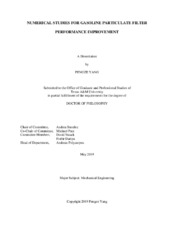| dc.description.abstract | The improvement in brake thermal efficiency of Gasoline Direct Injection (GDI) engines is accompanied by a significant increase in Particulate Matter (PM) and Particulate Number (PN) emissions as compared to (multi)Port Fuel Injected (PFI) engines. GDI-specific particulate filters (GPFs) with high filtration efficiency and low backpressure are required to meet the stringent PM/PN regulations (Manuscript #1). A 2-D GPF wall filtration model is created to determine the effects of pore size and distribution on the interdependent performance parameters of filtration efficiency and backpressure. Simulation results show a nonlinear change in filtration efficiency as the pore size distribution tightens and determines an optimal pore size distribution, by controlling the quantity of small size (less than 10m ) pores. Simulation results also inspire a novel filtration wall design with small pores comprising the top 40% of the wall layers and larger pores on bottom 60%. The model predicts that such a wall would result in an 8% increase in filtration efficiency at an expanse of 17.5% pressure drop increase (Manuscript #2). Further work modifies the GPF filtration model by moving away from the traditional unit collector model, to the proposed “throat unit collector” model, to better mimic the microstructure characteristics of GPFs. The throat unit collector model demonstrates its capability of predicting the filtration efficiency of blank sample GPFs accurately and simulating filtration efficiency change due to pore bridging (Manuscript #3). Finally, research on washcoating and ash-driven GPF wall heterogeneity effects on GPF performance was done using a 3D GPF model with particle tracking capability. A User Defined Function (UDF) was implemented to define and update the GPF wall properties and resolve the local particle filtration efficiency. The simulation results indicate the uniform washcoating shows the most promising performance with respect to the filtration efficiency and pressure drop. The model also suggests that pre-loading an ash cake is one way to achieve a balance between high filtration efficiency and low pressure drop (Manuscript #4), as seen in experimental results in the literature. | en |


